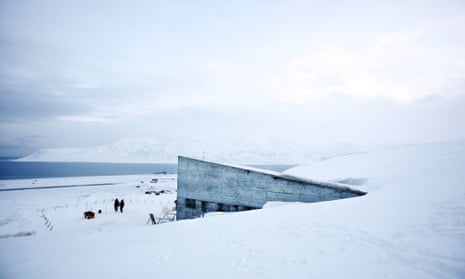On 10 September, Dr Mahmoud Solh, director general of the International Center for Agricultural Research in Dry Areas (Icarda), sent an urgent request to the Svalbard global seed vault asking for the return of collections of seeds once held in Aleppo, Syria.
A few weeks later, 128 crates of seeds holding around 38,000 samples of wheat, barley, lentil, chickpea, fava bean, pea, grass pea and legumes were removed from the vault located in the frigid, snow-packed archipelago halfway between Norway and the north pole.
These seeds are now being sown at research stations in Lebanon and Morocco in the hope that they will soon provide farmers and breeders in Syria, a country besieged by war, with new seeds and saplings.
Roughly 80,000 species from Syria’s collection remain in the vault, the backup system for the world’s seed collections known as the “Noah’s Ark of seeds”.
The withdrawal marked the first time the vault had been accessed, but it will likely not be the last. This is because, for the past century, there has been a dramatic reduction in the diversity of what we grow and eat.
We’re losing food diversity
Seeds are the building blocks of every meal we eat: our fruits and vegetables, our grains and pulses, plus the meat that’s raised on grass and grain. The loss of diversity of what we eat is a result of multiple factors, including the increased industrialisation and globalisation of agriculture that has seen farmers worldwide pushed to abandon multiple local plant varieties for genetically uniform, high-yielding varieties.
According to data from the United States Department of Agriculture (USDA), Monsanto and Syngenta, along with two other companies, control more than 70% of the entire proprietary seed market. The top eight companies control 94% of the commercial market and the USDA report adds that these shares will likely continue to rise.
When commercialised, both hybrids and genetically engineered seeds have to be repurchased every year because they won’t render consistent results if saved and used in subsequent plantings, or because they are protected as the “intellectual property” of seed companies. Those who control seeds ultimately control food.
Other contributing factors to the decline in diversity include pests and disease, global warming, habitat loss and socio-economic factors such as trade agreements, urbanisation, changing diets and a growing disconnect between farmers and consumers.
Today, 95% of the world’s calories come from 30 crops, according to the UN Food and Agriculture Organization. Analysis of 50 years of data on global diets confirms a worldwide trend toward meals comprising wheat, rice, potatoes, maize, soybean and palm oil. In areas of food insecurity, increased calories are vital, but it’s dangerous for the same reason – investment experts tell us – to diversify our financial holdings: putting all our eggs in one basket increases risk. One disease, one pest, or the volatility of a changing climate, can imperil them all.
Seed vaults alone aren’t the answer
The solution to this challenge has been placed almost entirely in the hands of conservationists who manage ex situ (out of place) collections, such as Icarda and the global seed vault, and repositories that hold genetic material ranging from microbes to honeybee sperm, plus field collections for plants that are not cultivated from seed (such as apples and grapes).
However, the vault and other stored collections have neither the space nor the resources to preserve the world’s myriad foods, and much of this material is saved under conditions where it can remain stable but is unable to respond to changing environmental conditions or threats.
This is why in situ (in place) conservation is also critical. This means conserving wild places, such as forests, in which plants and animals can thrive and evolve, as well as conservation by farmers through the cultivation of diverse breeds and plant varieties.
These methods are not guaranteed, however, because of the constant threat of deforestation and the fiscal challenges farmers face. Farmers, the stewards of food, operate on thin margins. They can’t be expected to grow crops or raise livestock for which there is no market.
We can make a difference
While mass production favours standardisation, smaller-scale producers recognise we can’t secure future food without diversification. This is where we, the eating public, come in. We can help support the businesses that are grappling with this challenge by developing a new way to preserve and sustain our agricultural biodiversity: saving foods by eating them. With few exceptions, consumers have been overlooked in the pursuit to save these disappearing foods. Yet, this fight can’t be won without us.
“Although it isn’t immediately obvious that eating olive oil would be radical, in the big picture that’s exactly what it is,” says conservationist Colin Khoury. “Eating olive oil is now a radical act. Eating anything that’s not rice, wheat, corn, soy or palm oil is radical.”
We can make a difference by seeking out diverse varieties of foods, by stepping out of the comfort zone of rice, wheat, maize, soya and palm oil and demanding the food industry offers diversity not only in flavour but also in the types of ingredients used.
Initiatives such as Slow Food’s Ark of Taste identify and preserve these endangered foods, but the revolution is humble and starts on our plates by looking at the pillars of our own diets and by making simple changes. The way to take back this power for ourselves is to understand why we eat what we eat, and to understand what we’re losing, so we know what to reclaim.

Comments (…)
Sign in or create your Guardian account to join the discussion